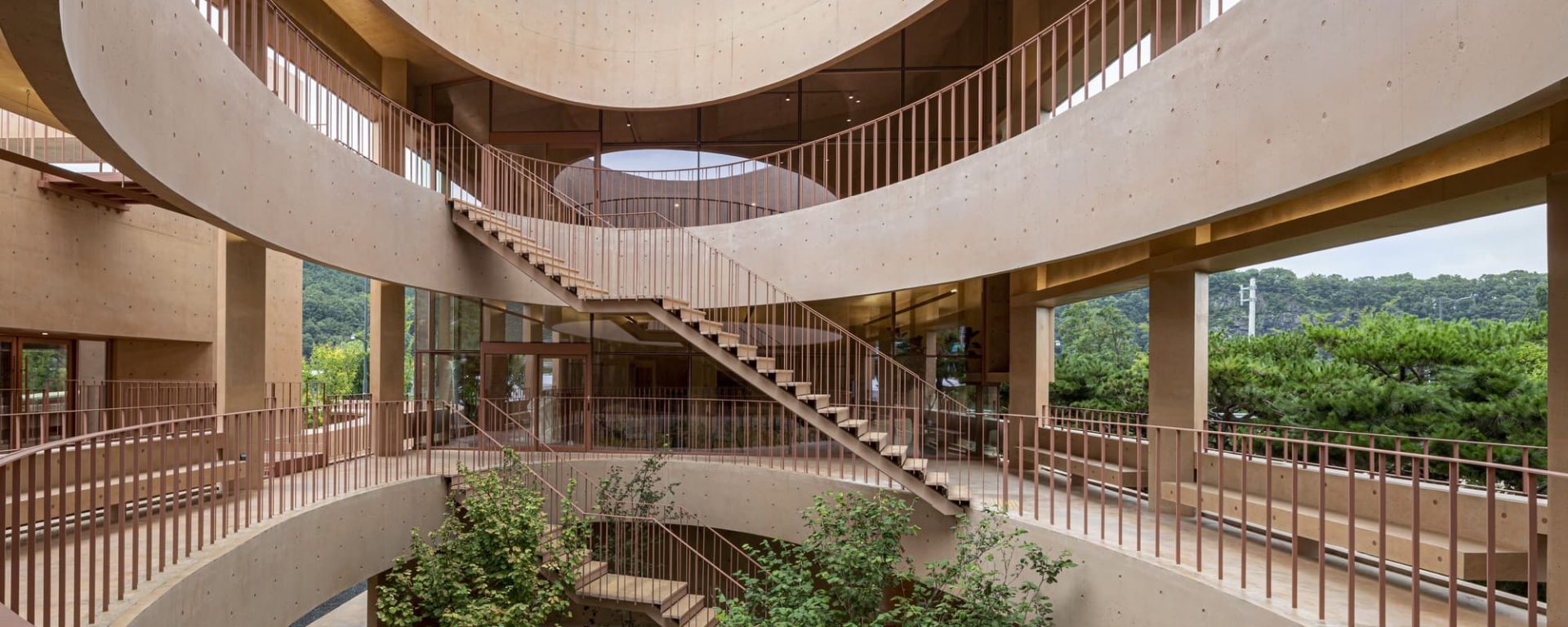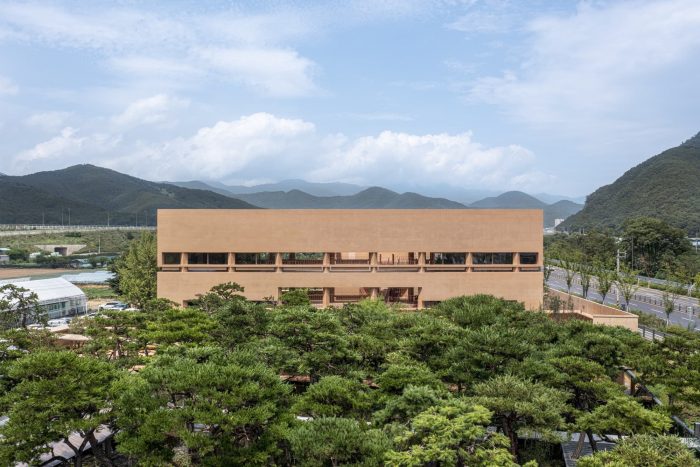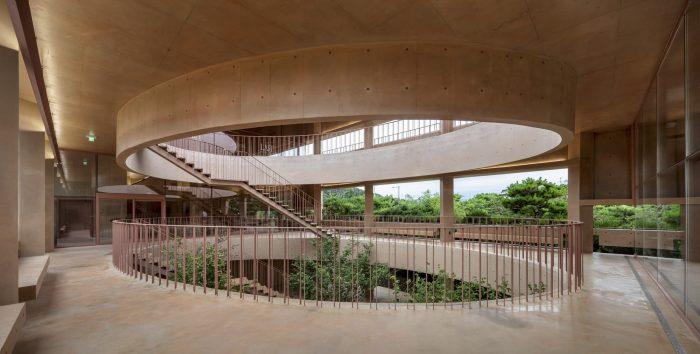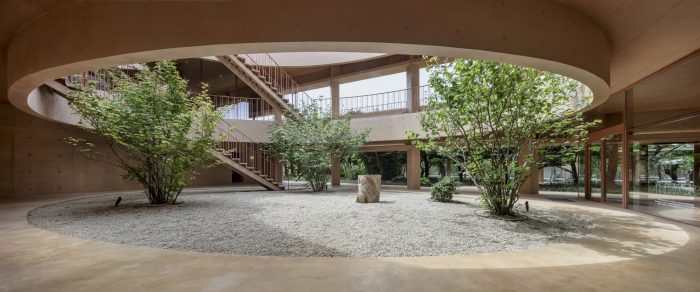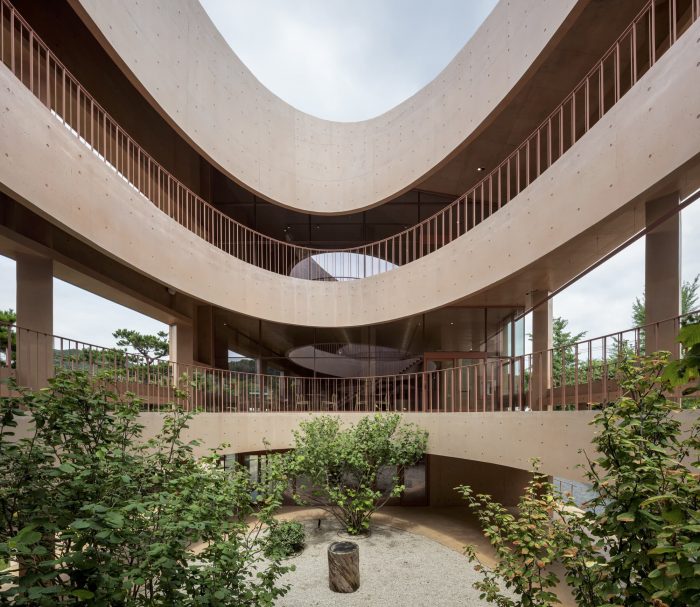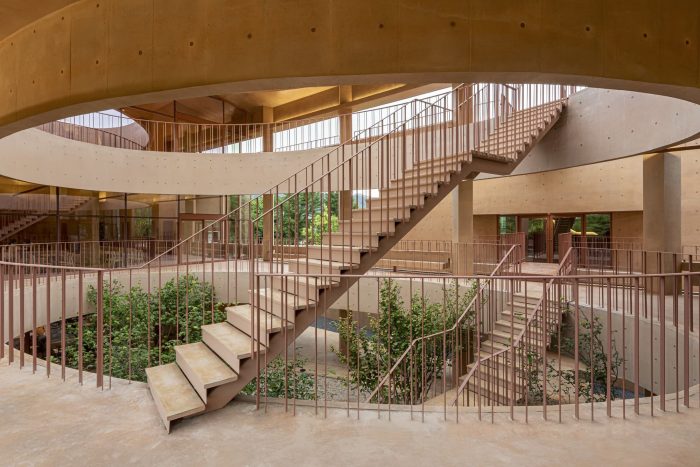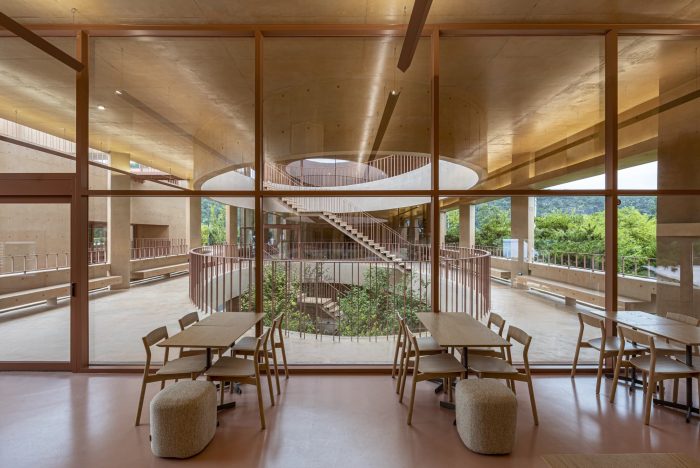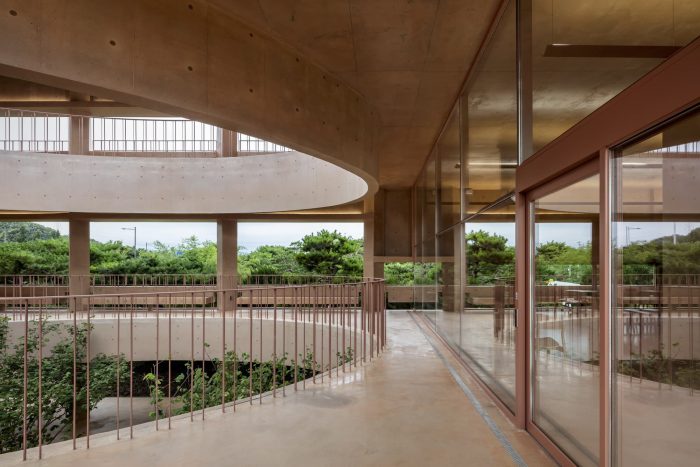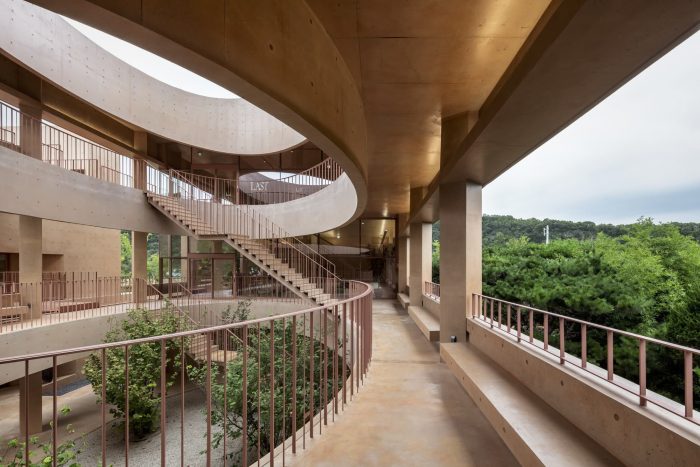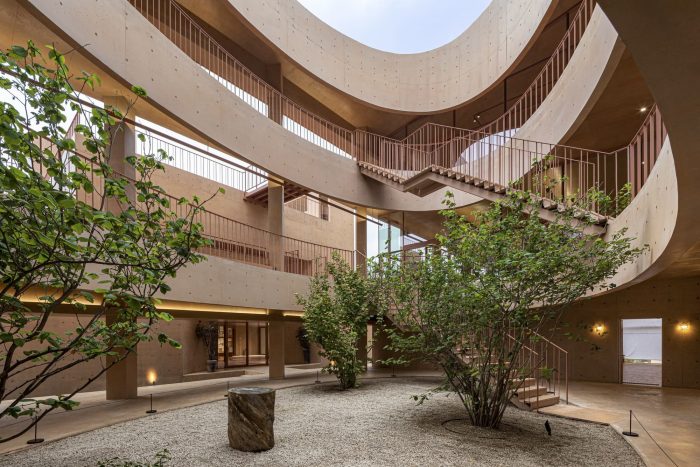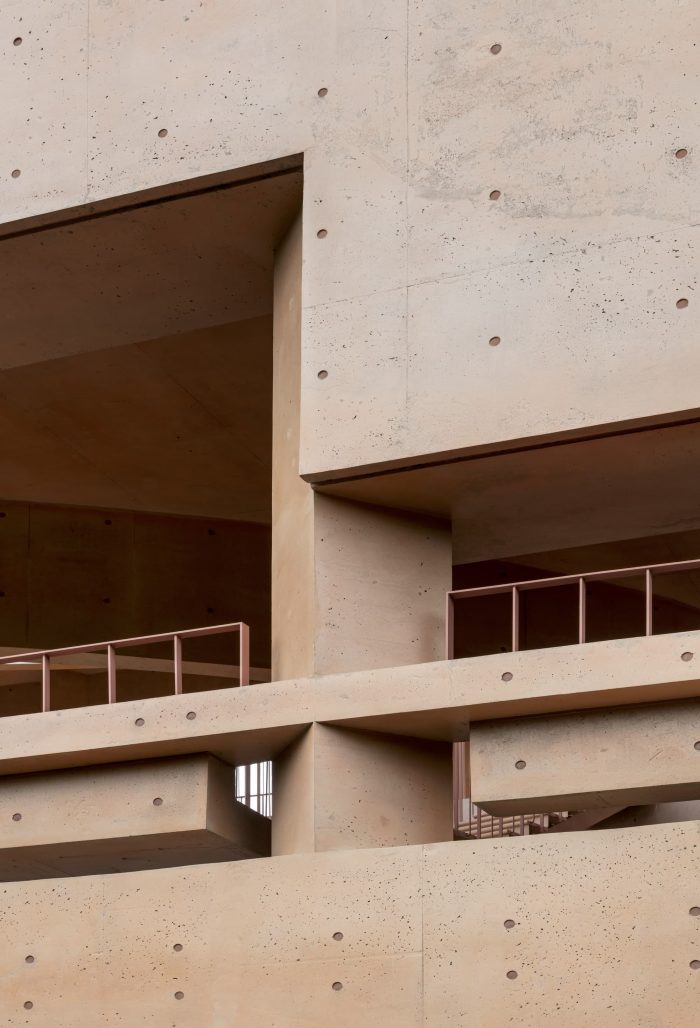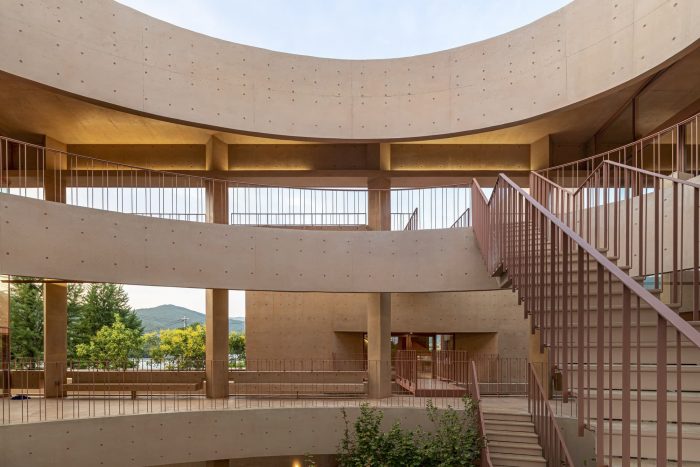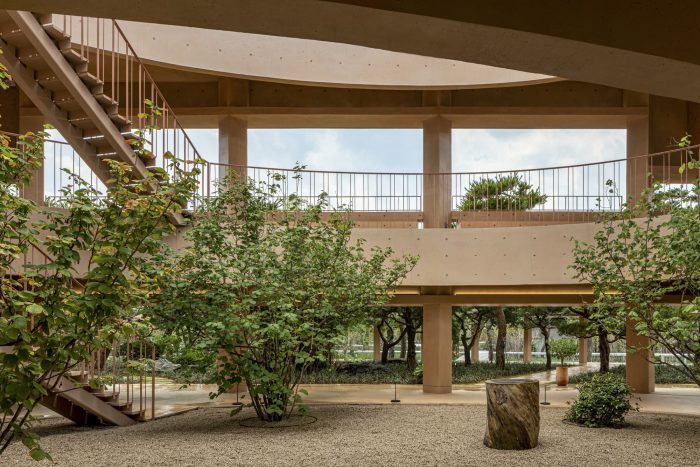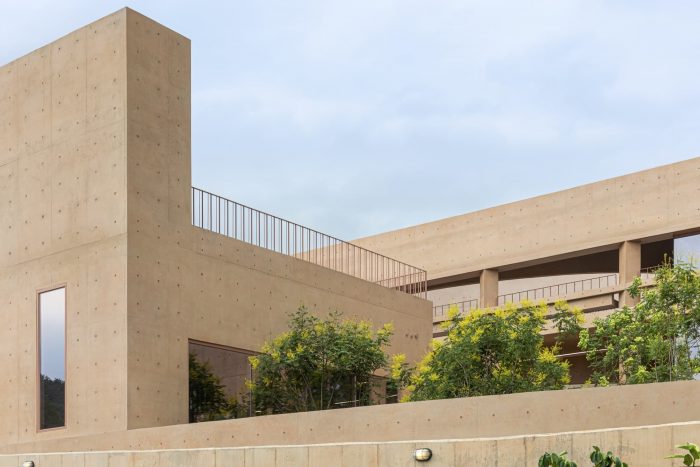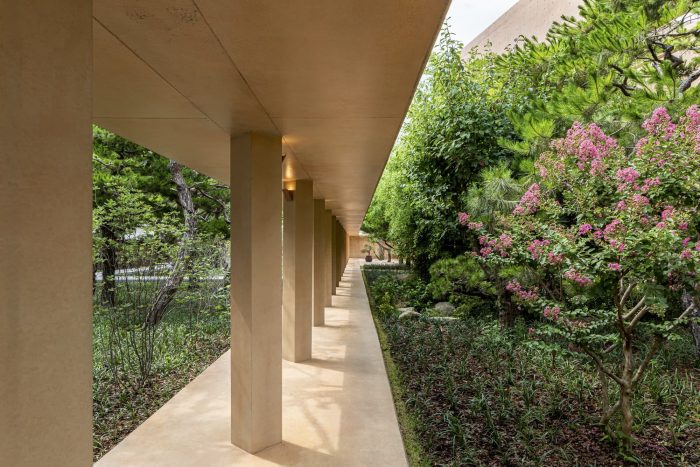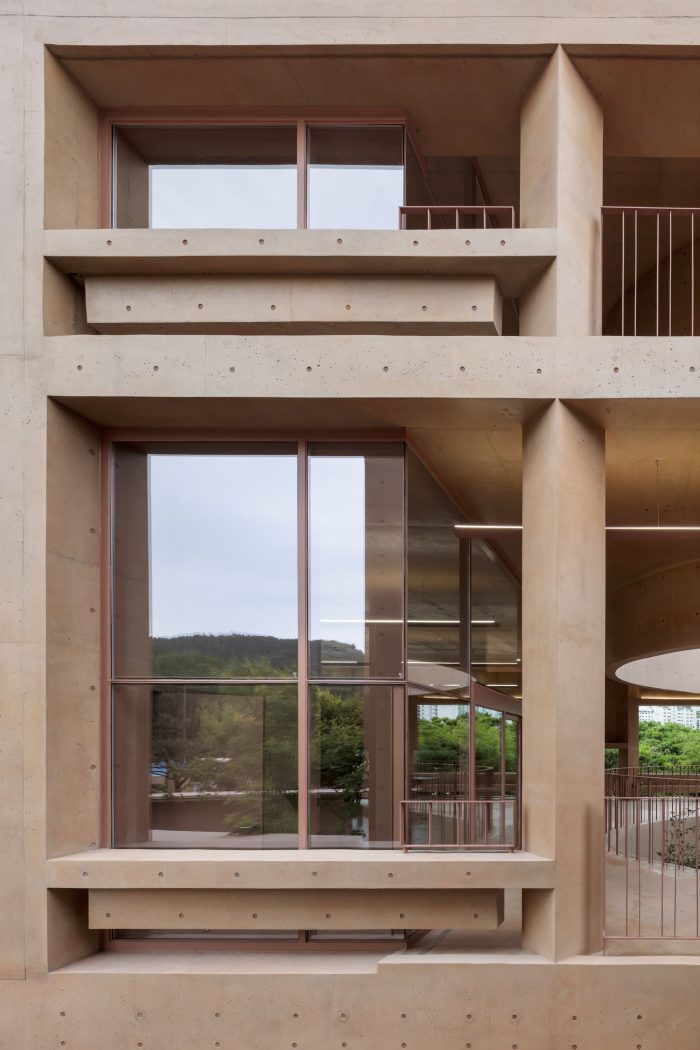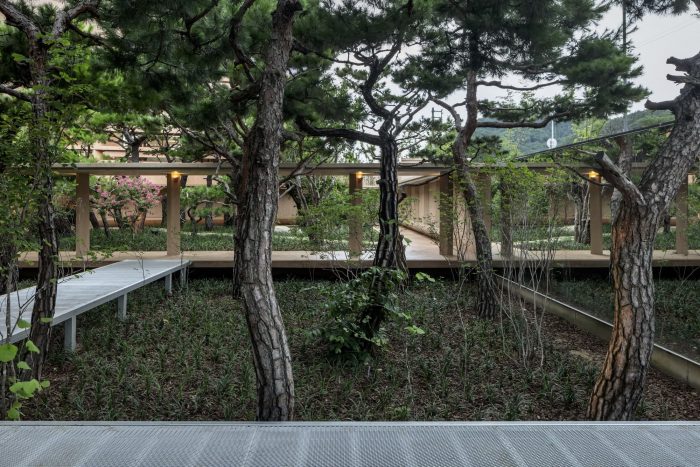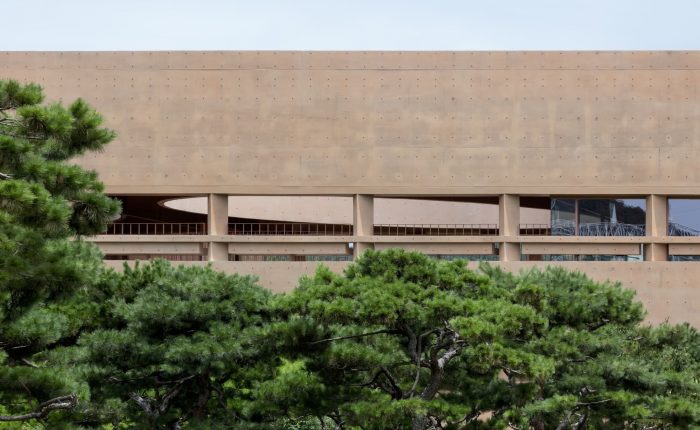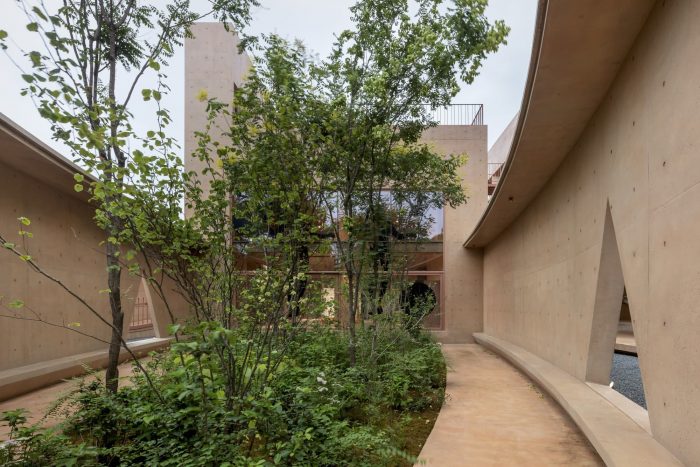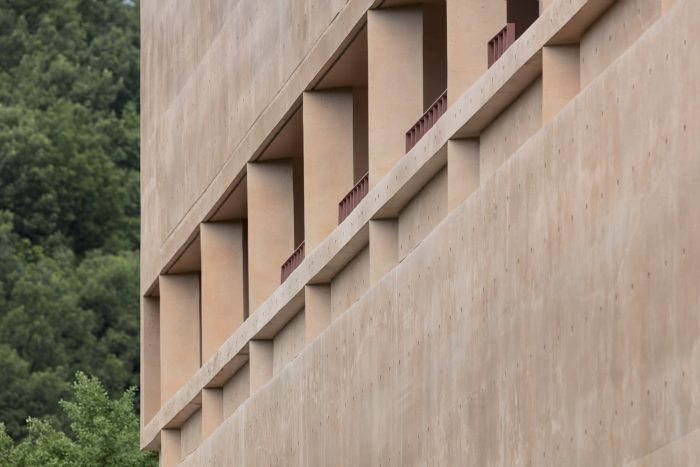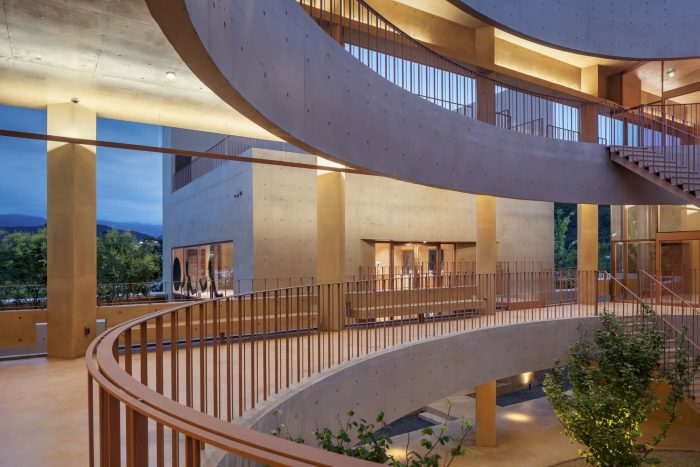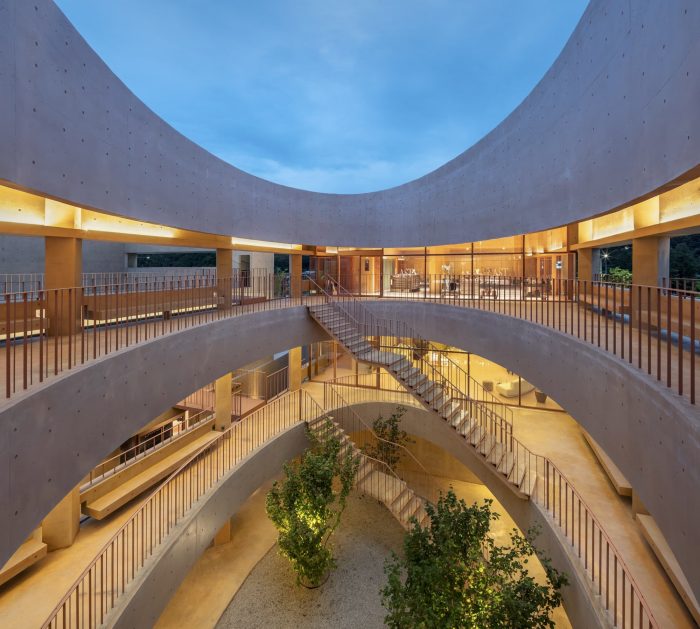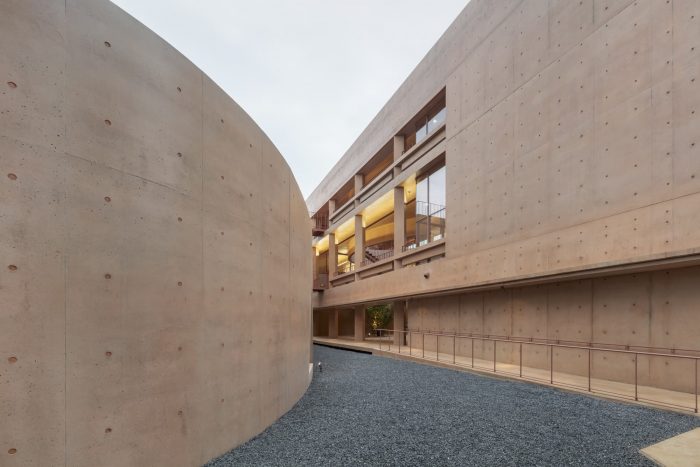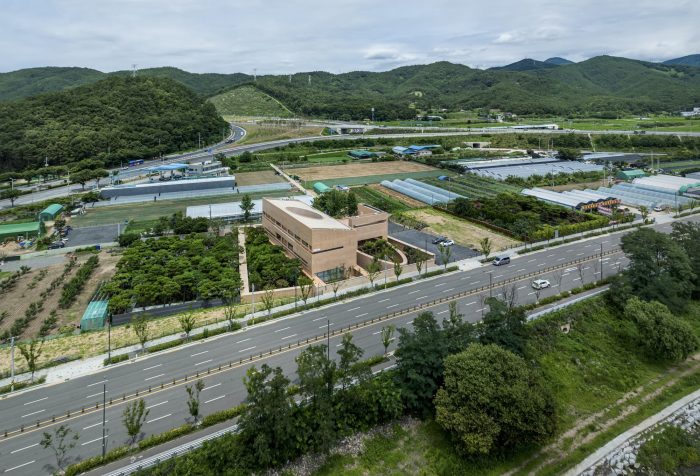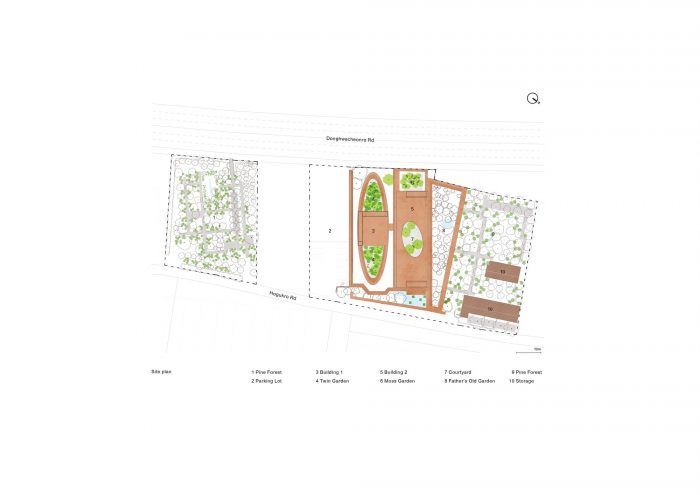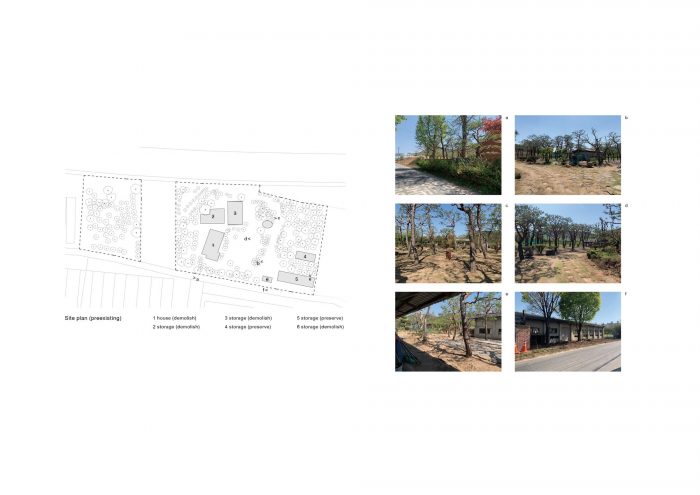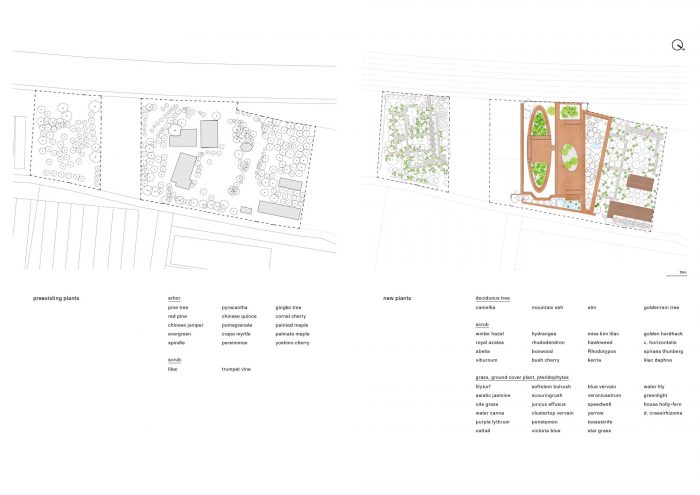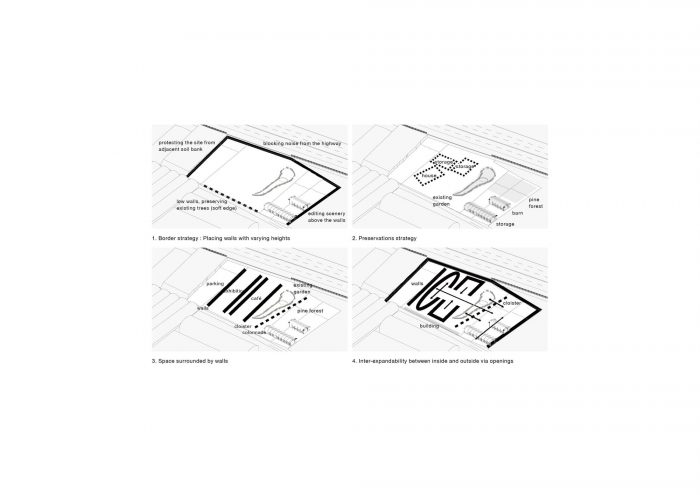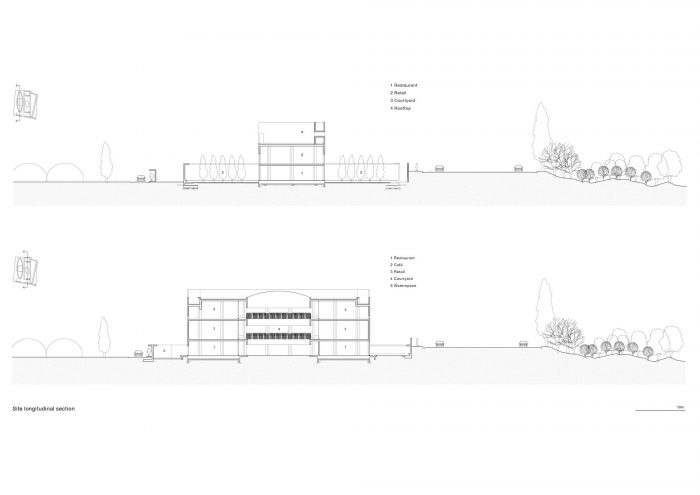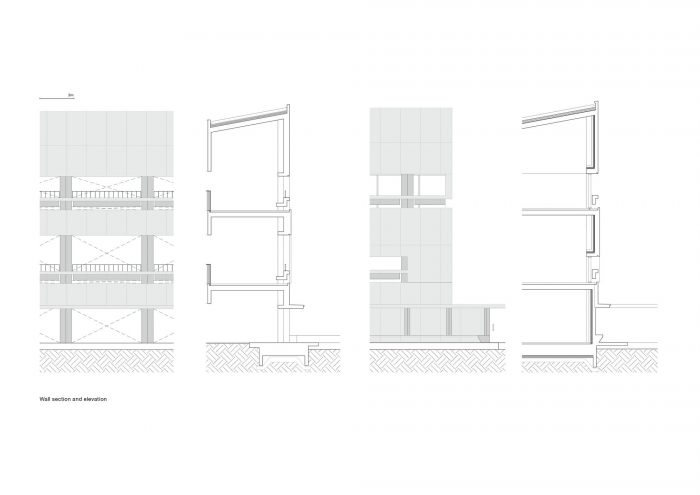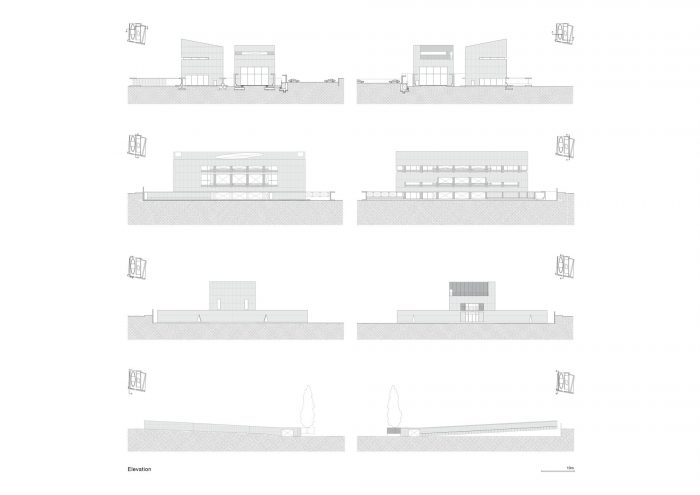场地条件 – MRNW大邱是一个将客户的父亲过去培育的继承的景观树农场改造成一个新空间的项目。该场地位于大邱的北部边界,被指定为限制开发区域,作为景观农场使用了20年。该地块的南侧面向东华川路(双向六车道),北侧面向虎谷路(单向单车道)。东华川路比场地水平面高约2.3米。场地面向Hoguk-ro的边界是由农场围栏和围栏上的松树组成。当项目启动时,场地上有很多景观植物,这些植物是客户的父亲凭着他对树木的感情种植了20年,也是为了出售。一个古老的花园在一个广阔的草坪院子里,五个仓库围绕着它排列,在管理用房的前面。
Conditions of the Site – MRNW Daegu is a project that transforms an inherited landscaping tree farm cultivated by the client’s father in the past, into a new space. The site located on the northern border of Daegu was designated as a restricted development area and used as a landscaping farm for 20 years. The south side of the site faces Donghwacheon-ro (two-way six-lane road) and the north side faces Hoguk-ro (one-way one-lane road). Donghwacheon-ro is about 2.3m higher than the site level. The boundary of the site facing Hoguk-ro was made of a farm fence and pine trees over the fence. When the project launched, the site was full of landscaping plants that the client’s father had grown for 20 years with his affection for trees and also for sale. An old garden was in an expansive lawn yard and five warehouses were arranged around it, in front of the management housing.
建立建筑与景观之间的关系–场地里有很多景观植物,是客户的父亲带着对树木的个人感情种植了20年的,也是为了出售。有一个公司管理用房和五个仓库;建筑物周围的场地种植密度接近于森林。其中一些有一个古老的复古花园,显示了客户父亲的品味。该项目是通过为新建筑寻找位置开始的。在拆除和保留之间找到平衡点,并尽量减少迁移的树木数量是这个过程的重要考虑因素。森林是一种原始形式的庇护所,由蓬松质地的屋顶和支撑它的柱子组成,能在一定程度上穿透阳光和雨水。基本上,在建筑设计和建造的相对较短的时间内,很难模仿或人为地创造出20年的时间造就的森林氛围。但相反,新增加的建筑有可能会积极利用这一遗产。整个场地的总体规划是靠森林形成的,或者说是增加了与森林的对比。
Establishing the Relationship between Architecture and Landscape – The site was full of landscaping plants that the client’s father had grown for 20 years, with a personal affection for trees, and also for sale. There were a company management housing and five warehouses; The site around the buildings was planted at a density close to that of a forest. Some of them had an old vintage garden that showed the tastes of the clients’ fathers. The project was started by finding a spot for the new building. Finding the balance between demolition and retention and minimizing the number of trees relocated were important considerations for this process. A forest is a primitive-form shelter that is composed of a fluffy-textured roof that somewhat penetrates sunlight and rain, and columns supporting it. Basically, it is difficult to imitate or artificially create the atmosphere of the forest that 20 years of time made, within a relatively short time period where architecture is designed and built. But instead, there is a possibility that the newly added architecture will actively utilize this heritage. The master plan of the entire site was formed by leaning against the forest or adding contrast to the forest.
场地的东南侧面向一条高度为2米的干道,西北侧面向一条后路。从建筑中延伸出来的围墙被用来保护建筑群免受上下道路的噪音和车辆速度的影响,并创造出综合的地域性。除了围墙之外,从建筑中突出的屋檐、走廊和融入外墙的长椅被用作与面对建筑的花园相对应的建筑元素。走廊环绕着古色古香的花园,附在墙上的长椅让人们可以看到这个花园。在通过这两座建筑时,人们会从约两米高的低矮屋檐下经过,这样空间就会被清晰地转换。
The southeast side of the site faces an arterial road having a height of 2 meters and the northwest side of the site faces a back road. An extended perimeter wall from the architecture is used to protect the complex from the noise of the upper and lower roads and from the speed of the vehicle and to create integrated territoriality. In addition to the perimeter wall, the eaves protruding from the building, the corridor, and the benches integrated into the exterior wall are used as architectural elements corresponding to the garden facing the buildings. The corridor surrounds the quaint old garden, and the benches attached to the walls allow people to look at this garden. When passing through the two buildings, people would pass under the low eaves about two-meter in height, so that the space would be clearly converted.
内部和外部空间的叙事构成–这两座建筑在平面图上的纵向方向上各分为三个区域。1号楼中间是客厅,两边是院子;2号楼的设计是中间是院子,两边是客厅。通过将两栋建筑在南北方向并排布置,1号楼的内部与2号楼的庭院相遇。具有3×3结构的主要内部和外部空间相互连接,最后延伸到客户父亲的 “复古花园”,面向2号楼。整个场地,包括两栋楼之间的室外空间,都是以室内和室外相交的方式建造的。我们希望通过将内部和外部放在同一条线上,将室外视为 “外面的房间”。在MRNW大邱,通过走廊和围墙连接各种元素,内部和外部的界限被模糊了:一栋两边有镜面花园的建筑,一栋有开放庭院的建筑,这两栋建筑之间有一个内外相对的编织区域,一个古老的花园和一片松树林。
The Narrative Composition of Interior and Exterior Spaces – The two buildings are each divided into three zones each in the longitudinal direction on the plan. Building 1 has a living room in the middle and a courtyard on both sides; Building 2 was designed with a central courtyard and a living room on both sides. By arranging the two buildings side by side in the north-south direction, the interior of Building 1 meets the courtyard of Building 2. The main interior and exterior spaces with 3 x 3 structures are connected to each other, finally extended to the client’s father’s ‘vintage garden’ facing Building 2. The entire site, including the outdoor space between the two buildings, was constructed in a way that the interior and exterior are intersecting. We would like to consider the outdoors as ‘the room outside’, by placing the inside and outside on the same line. In MRNW Daegu, the boundaries between inside and outside were blurred by connecting various elements through corridors and perimeter walls: a building with a mirror garden on either side, a building with an open courtyard, an area between these two buildings with opposite internal and external weaving, an old garden and a pine grove.
就像韩国传统建筑的布局一样,这些空间可以给人以非同寻常的体验;例如,在沿着围墙行走后,游客打开门进入某个地方,但却到了外面的空间;或者有时,打开门离开某个地方,却到了室内空间。作为参考,Soswaewon花园将森林中的建筑和它的外部组织成一个通过开放的围墙的连续流。我们从这个古老的花园中学习,得出了大邱MRNW的规划策略。因此,建筑的围墙、走廊和外墙完全界定了邻近外部空间的地域性。内部和外部通过一个中间区域相遇,如院子的屋檐或露台。平面布局的完成是通过内部和外部的叙事连接实现的。
Like the layout of traditional Korean architecture, these spaces could give extraordinary experiences; for example, after walking along the perimeter walls, visitors open a door to enter somewhere, but to an outside space; or sometimes, open a door to exit somewhere, but to indoor space. As a reference, Soswaewon Garden organizes buildings in the forest and its exterior as a continuous flow through open perimeter walls. We learned from this old garden and came up with the planning strategy for the MRNW Daegu. As a result, the perimeter walls, the corridors, and the exterior walls of the buildings are defining altogether the territoriality of the adjacent exterior space. The interior and exterior meet through an intermediate area such as the eaves or terrace of the courtyard. The completion of the plan layout is achieved through internal and external narrative connections.
简单的几何形状和纪念碑式的庭院–简单的几何形状使空间具有强烈的特征。简单的几何学有各种效果,这取决于它是作为一种体积感而存在,还是作为一种空旷而存在。当它包括规模因素时,它甚至可以包含一种纪念性。空间虽小,但通过移除或并列对比类型的形状,如椭圆和正方形,包含了强烈的中心性。椭圆形的空隙空间成为一条通道,或者成为界定花园的墙壁。简单几何图形的间隔突出了不同的空间区域。这种特质使人们能够想象到周围环境之外的空间,如果只应用规则的网格,就很难猜到。
Simple Geometry and Monumental Courtyard – Simple geometry gives the space a strong identity. Simple geometry has various effects depending on whether it exists as a sense of volume, or it exists as an emptiness. It can even contain a monumentality when it includes the scale factor. The space is small but contains a strong centrality by removing or juxtaposing shapes of contrasting types such as ellipses and squares. The oval-shaped void space becomes a passage path or becomes a wall that defines the garden. The interspaces of the simple geometries highlight different spatial areas. This quality allows people to imagine the space beyond their surroundings that would be difficult to guess if only applied a regular grid.
元素。围墙、屋檐、走廊、柱子和吊墙–在城市中,”围墙 “经常被用来形象地描述所有权,特别是以防御的方式;然而,大邱MRNW拥有宽松的场地条件,我们希望利用围墙作为有效的设计元素,使人们沿着围墙行走,或为户外空间增加丰富的内容。特别是在MRNW大邱,农场上密密麻麻的现有树木将围墙作为背景引入,让它们展现出自己的外观。在一个简单的平面系统中,建筑元素如围墙、屋檐、走廊、柱子、吊水墙和外墙长椅被使用,以确定建筑之间的空间特征和建筑对花园的姿态。从建筑中延伸出来的围墙是指定户外区域的主要设计元素。此外,墙壁和走廊也起到了让人们感觉到外部空间就像与建筑物相邻的房间一样的作用。
Elements: Perimeter Wall, Eave, Corridor, Column, and Hanging Wall – In cities, ‘Perimeter wall’ is often used to visualize ownership, especially in a defensive manner; however, MRNW Daegu has a generous site condition, and we wanted to leverage the perimeter wall as an effective design element that makes people walk along it or adds abundance to the outdoor space. Especially in MRNW Daegu, the densely planted existing trees on the farms bring in the perimeter wall as a background, allowing them to reveal their own appearance. In a simple plan system, architectural elements such as perimeter walls, eaves, corridors, columns, hanging water walls, and exterior wall benches are used in order to define the characteristics of the space between buildings and the gesture of the architecture towards the garden. The perimeter walls extended from the buildings are the main design elements that specify an outdoor area. Moreover, the walls and corridors also play a role in making people feel the external space like a room adjacent to the buildings.
特别是,走廊穿过并分隔了客户父亲的旧花园和松树林,以便将这两个空间分类。这是为了创造一个新的多层次的空间深度,通过模糊地划分以前没有界限的空间和定义区域。所有的柱子都以轴线为基础旋转45度,这构成了主要外部空间的边界,并在立面上形成了三维的效果。屋檐被设计成人们可以触及的2米高,当空间转移时,可以最大限度地提高下一个空间的开放性;悬挂的水墙也是强调垂直度和椭圆建筑的椭圆形庭院形状的手段。外墙上的长椅为倚靠建筑而坐的人们提供了朝向邻近外部的视野。为了使建筑元素融入建筑的简单几何体量中,我们采用了裸露的混凝土作为主要的建筑材料。柱子、屋檐、围墙和走廊都被纳入建筑外壳,形成厚实的立面。
In particular, the corridor crosses and separates the client’s father’s old garden and the pine grove in order to classify the two spaces. This is to create a new multi-layered spatial depth by vaguely dividing the previously unbounded space and defining the area. All columns are rotated 45 degrees based on the axis, which constitutes the boundary of the main external space and creates three-dimensional effects on the façade. The eaves are designed to be 2-meter high that people can reach, which maximizes the openness of the next space beyond when the spaces are shifted; The hanging water walls are also means of emphasizing verticality and the shape of the oval courtyard of the ellipse building. The benches on the exterior walls provide a view towards the adjacent outside for people who sit leaning against the building. The exposed concrete was adopted as the main construction material in order for architectural elements to be integrated into the simple geometric volume of the building. Columns, eaves, perimeter walls, and corridors are incorporated into the building shell, which forms a thick elevation.
厚墙和表面深度–为了突出厚墙在内部和外部之间的调解方式,我们想表达表面的深度和体积。在MRNW大邱,我们试图通过单独突出所有的水平和垂直元素来揭示墙体支持内部和外部的姿态:与墙体结合的长椅、旋转45度的柱子、遮阳篷、开口等等。通过这种方式,表面在外墙的厚度范围内被凹陷和突出;它显示出各种阴影,并随着时间的推移给出不同的表达。特别是,面对松树林的三层外墙,不仅是一个框架和装置,从建筑内部可以看到森林,也是一个元素,从建筑外部成为森林的背景。
Thick Walls and Surface Depth – In order to accent the way the thick wall mediates between the inside and the outside, we wanted to express the depth and volume of the surface. In MRNW Daegu, we tried to reveal that the walls support both gestures of the interior and exterior by individually highlighting all horizontal and vertical elements: benches integrated with the wall, columns rotated by 45 degrees, awnings, openings, et cetera. Through this, the surfaces are dented and protruded within the range of the thickness of the exterior wall; it shows various shadows and gives different expressions over time. In particular, the three-story façade facing the pine grove is not only a frame and a device that provides a view of the forest from the inside of the building but also an element that becomes the background of the forest from the outside of the building.
叙事空间–进入狭窄的入口,穿过淡粉色的裸露混凝土墙,一些树木一起映入眼帘:两棵现有的柿子树,形状和类型都很好,还有一棵新栽的金丝楠木,在围墙上开着黄色的花。这个场景是衡量MRNW计划概念的一个重要线索。MRNW从孩子们几代人对他们父亲那一代人耕种的茂密而古老的花园的平面和剖面的精心干预开始。建筑物可以成为树木的背景,或者通过视觉控制充当框架。此外,在裸露的混凝土墙的阴影下,它成为一条看花园的路线,以及通过进入树荫下的平台。MRNW分为五个区域,其中停车场、咖啡馆、花园、庭院、古朴的老花园和松树林依次重叠在一起。室内空间的放置方式与室外区域相交,实现了几种组合的视觉关系。参观者在这里会体验到多样化和不同的印象。当人们转过入口坡道,走向主入口时,他们会遇到一系列丰富多彩的场景。
Narrative Space – Entering the narrow entrance, through the pale pink exposed concrete wall, some trees come into view together: two existing persimmon trees having good shape and types and a newly planted Goldenrain tree with yellow flowers over the perimeter walls. This scene is an important clue to gauge the concept of MRNW’s plan. MRNW starts with the planar and sectional careful intervention of the children’s generations in the dense and old garden cultivated by their father’s generation. Buildings can be the background of trees or serve as frames through visual control. Furthermore, it becomes a route looking at the garden under the shadow of the exposed concrete wall, as well as a platform by going into the shade of a tree. MRNW is divided into five areas in which parking lots, cafes, a garden, a courtyard, a quaint old garden, and a pine forest are overlapped in sequence. The indoor space is placed in a way that intersects with the outdoor area, enabling visual relations of several combinations. Visitors to this place will experience diverse and different impressions. As people turn around the entrance ramp and head towards the main entrance, they will come across a series of colorful scenes.
被分割的两座建筑被放置在场地的一个侧面,自然形成了多个层次。椭圆形规划的墙体和直线型的墙体相接,形成不同宽度的空间,裸露的混凝土天棚调整高度,保持空间张力。由涂层胶合板制成的光滑的裸露混凝土不断拥有强烈的阴影形式,45度旋转的方形柱子为迷人的空间做出了贡献。除了建筑中的空间外,新的景观和不锈钢墙被添加到古老的松树林中,它们也增强了空间的活力。为了让人们从不同的高度感受到古老的松树林,在地板上约五级台阶的高度上安装了钢制甲板。通过一个最小的翻新过程,两个旧仓库创造了粗糙的阴影,游客可以在这里穿越到过去。这是一个由不确定的程序、不同时代的树木和建筑之间的关系创造的动态景观。
The divided two buildings are placed on a single side of the site, naturally forming multiple layers. The oval-planned and straight-lined walls meet to create various widths of space, and the exposed concrete canopy adjusts the height to keep the spatial tension. The smooth exposed concrete made of coated plywood constantly boasts an intense form of shadows, and the 45-degree rotated square columns contribute to the glamorous space. In addition to the spaces in the building, the new landscaping and stainless steel walls were added to the old pine forest and they also enhance the vitality of the space. Steel decks were installed at a height of about five steps on the floor in order for the old pine forest to be experienced from a different height. Through a minimal renovation process, two old warehouses create rough shades where visitors can travel to the past. It is a dynamic landscape created by the relationship between indeterminate programs, trees from different eras, and architecture.
Architects: Society of Architecture, Yerin Kang
Area : 1384 m²
Year : 2022
Photographs :Texture on Texture, Kyungsub Shin
Manufacturers : Behr, Namsun Aluminum
Structural Engineering : Base Structural Consultants
Construction : Mirero
Mechanical Engineering : Ju-Sung ENG
Electrical Engineering : Chung Song Engineering & Construction
Landscape Design : design studio loci
Architect : Chihoon Lee, Joohee Han, Yerin Kang, Jeongyeon Lee, Haeun Rim
City : Daegu-si
Country : South Korea

